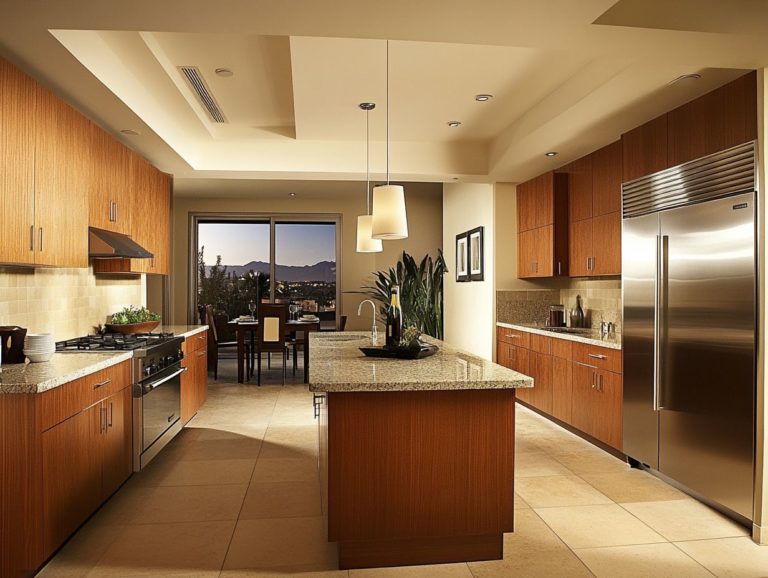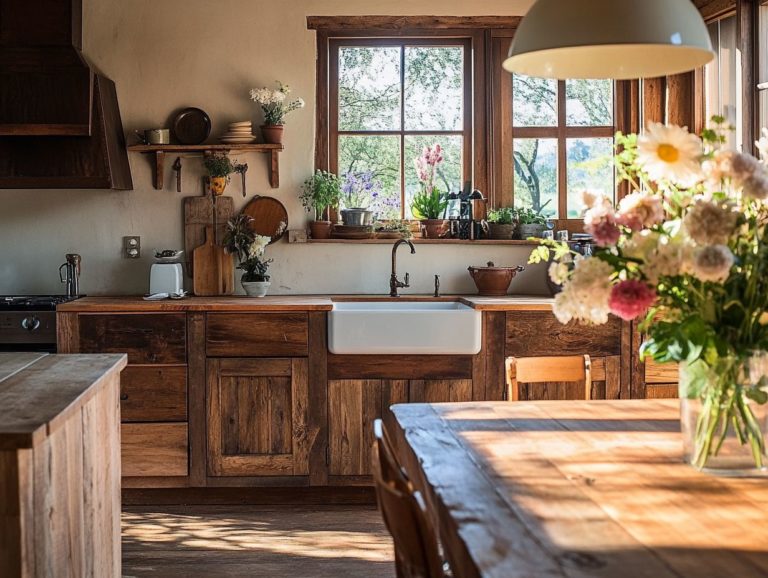5 Unique Materials for Kitchen Cabinets
Are you tired of traditional kitchen cabinet designs that seem to fill every home? It’s time to explore innovative alternatives that not only enhance your kitchen’s look but also promote sustainability.
Consider checking out five unique materials for your kitchen cabinets:
- Bamboo
- Reclaimed Wood
- Stainless Steel
- Glass
- Recycled Plastic
In this discussion, you’ll discover the benefits of each material, how they compare to traditional wood, the various styles and finishes available, essential maintenance tips, and their transformative potential for your kitchen—turning it into a modern masterpiece.
Discover the exciting options waiting for you!
Contents
- Key Takeaways:
- 1. Bamboo
- 2. Reclaimed Wood
- 3. Stainless Steel
- 4. Glass
- 5. Recycled Plastic
- What Are the Benefits of Using Non-Traditional Materials for Kitchen Cabinets?
- Frequently Asked Questions
- What are five unique materials used for kitchen cabinets?
- What makes bamboo a unique material for kitchen cabinets?
- How is stainless steel a unique material for kitchen cabinets?
- Why is reclaimed wood a unique material for kitchen cabinets?
- What makes glass a unique material for kitchen cabinets?
- How is concrete a unique material for kitchen cabinets?
Key Takeaways:

Bamboo cabinets are a sustainable and eco-friendly choice for the kitchen, providing a unique and modern look. Reclaimed wood cabinets add character and charm while reducing environmental impact by using recycled materials. Stainless steel cabinets are durable, easy to maintain, and offer a sleek industrial appearance.
1. Bamboo
Bamboo is a popular choice for kitchen cabinets, combining sustainability and style to elevate modern interior design. Its unique look not only catches the eye but also aligns well with eco-friendly kitchen trends.
Designers like Richard Davonport and Helen Parker embrace innovative materials like bamboo, making it a sought-after option.
Unlike traditional solid wood or plywood, bamboo impresses with its strength-to-weight ratio, providing a robust alternative without sacrificing elegance. Its finish can range from sleek and contemporary to warm and rustic, allowing it to fit seamlessly into any kitchen theme.
Maintaining bamboo is simple; occasional cleaning and conditioning are all it takes to keep it looking fresh. With its natural resistance to moisture and pests, bamboo promises longevity while adding sophistication and earthy charm to your kitchen space.
2. Reclaimed Wood
Reclaimed wood is becoming a star in kitchen cabinets due to its sustainability and distinctive character. It brings historical charm and individuality to modern kitchens, showcasing your commitment to eco-friendly practices.
Each piece of reclaimed wood tells a story, creating a captivating focal point that contrasts beautifully with the uniformity of traditional materials like melamine and laminate. When styled thoughtfully, it can integrate seamlessly into various design aesthetics, from farmhouse chic to industrial elegance.
This versatility allows you to infuse warmth and authenticity into your cooking area while making a positive choice for the planet. Reclaimed wood is often more durable and resilient than modern counterparts, proving that sustainability can coexist with quality and style.
3. Stainless Steel
Stainless steel has become the hallmark of modern kitchen design, providing a sleek industrial look paired with outstanding durability. Its resistance to stains and scratches makes it a top pick for homeowners and designers who appreciate seamless integration with materials like glass-fronted cabinets and laminate finishes.
Unlike traditional wooden cabinets that may warp or scratch over time, stainless steel offers a long-lasting solution that requires minimal upkeep. Its non-porous surface ensures easy cleaning—just use a soft cloth and some mild detergent, and you’re set.
Aesthetically, stainless steel pairs beautifully with various design themes; its reflective surface can brighten any space while complementing contemporary and industrial styles. This versatility allows it to blend seamlessly with rustic elements, creating a captivating balance that enhances your kitchen design.
Ready to transform your kitchen? Let’s dive into these unique materials together!
4. Glass

Glass-fronted cabinets elevate modern kitchen designs, infusing them with an open and airy ambiance while showcasing your decorative moldings and stylish dishware. This choice enhances the visual appeal of your space and integrates functionality into cabinetry, making it a sought-after trend among designers aiming to create a custom look.
You may explore various styles, like frosted glass for an elegant touch or clear glass to provide an unobstructed view of your treasured items. Pairing glass with materials such as solid wood can create a warm and inviting atmosphere, while thermofoil, a type of material that is durable and easy to clean, introduces a contemporary edge.
Maintenance is key; glass readily reveals fingerprints and dust, so regular cleaning is essential to keep it looking pristine. By thoughtfully balancing these elements, you can achieve a sophisticated design that is both timeless and functional.
5. Recycled Plastic
Recycled plastic is making waves as an innovative material for your kitchen cabinets, merging sustainability with durability in a chic, eco-friendly approach to modern design. Its impressive ability to withstand moisture and wear makes it the perfect choice for busy kitchens.
This material appeals to homeowners and designers who value both environmental responsibility and aesthetic charm in their cabinetry selections. Unlike traditional materials that often require extensive upkeep, cabinets crafted from recycled plastic demand minimal maintenance. You can relish the beauty of your kitchen without the hassle of constant repairs or refinishing.
This material offers a stunning array of colors and textures and can mimic the look of natural wood or stone, granting you flexibility in design that aligns perfectly with current trends. It fits seamlessly into contemporary kitchen aesthetics while championing a more sustainable lifestyle, making it an enticing option for conscientious consumers like you.
What Are the Benefits of Using Non-Traditional Materials for Kitchen Cabinets?
Using non-traditional materials for your kitchen cabinets can unlock a realm of unique ideas that enhance both functionality and aesthetic charm while ensuring durability and sustainability in design. Materials like bamboo and recycled plastics inject a modern flair into your space and meet the rising demand for eco-friendly options in contemporary kitchen trends.
The advantages of these innovative choices are plentiful. They often outshine traditional materials regarding longevity and ease of maintenance. Take bamboo, for instance; its impressive strength-to-weight ratio makes it resilient against the daily wear and tear of a bustling kitchen.
Similarly, reclaimed wood brings character to your design while promoting sustainability by reducing waste. You might also find joy in the versatility of materials like recycled aluminum, which can be shaped into various styles, seamlessly blending functionality with creativity.
These alternatives typically demand less upkeep, as many are engineered to resist moisture and stains. This ensures that those vibrant finishes hold their luster far longer than conventional cabinetry.
How Do These Materials Compare to Traditional Wood Cabinets?
Non-traditional materials present unique advantages over traditional wood cabinets, such as enhanced durability, diverse aesthetic choices, and often a lower environmental impact. This positions them as a compelling option for modern kitchens.
By exploring materials like bamboo and recycled plastic alongside standard solid wood or plywood, you can gain insights into which cabinetry solution best aligns with your design aspirations and practical needs.
Take bamboo, for example; it’s renowned for its remarkable strength and moisture resistance, making it perfect for high-traffic areas. On the other hand, recycled plastics boast impressive resilience against scratches and dents, ensuring long-lasting beauty with minimal maintenance.
In contrast, traditional wood demands regular sealing and polishing to maintain its allure, a process that can easily become a chore. Regarding aesthetics, non-traditional materials offer various finishes and colors that seamlessly complement contemporary décor trends, providing a flexibility that classic wood often lacks.
Innovations in these materials, including textures that emulate natural grains or sleek matte surfaces, enhance their visual appeal, capturing the essence of modern design effortlessly. Explore these materials today to transform your kitchen!
What Are the Different Styles and Finishes Available for These Materials?

The array of styles and finishes available for non-traditional materials in kitchen cabinets give you the power to customize your designs to match your unique aesthetic while reaping the benefits of modern materials.
From sleek glass finishes to textured patterns in laminate and thermofoil, these options expand your creative horizons, allowing you to achieve a bespoke look in any kitchen setting.
You might find yourself drawn to the natural beauty of bamboo, which infuses a warm, organic feel that beautifully complements contemporary designs.
Alternatively, consider recycled plastic cabinets—their vibrant hues and eco-friendly attributes can seamlessly harmonize with both modern and rustic themes.
If you prefer a more industrial vibe, stainless steel offers a stylish addition that fits well with a minimalist approach.
Integrating non-traditional materials can create a kitchen that reflects current design trends. It also preserves a connection to classic elements, resulting in a stylish and functional space.
What Are the Maintenance Requirements for These Materials?
Understanding the maintenance needs for non-traditional materials in your kitchen cabinets is crucial for achieving both longevity and aesthetic appeal. Each material—be it bamboo, stainless steel, or recycled plastic—has its own specific care guidelines that play a key role in preserving its durability and appearance over time.
Unlike traditional wood cabinets, which often demand regular polishing and treatments to fend off warping or moisture damage, non-traditional options typically offer enhanced resistance to such issues. Bamboo requires occasional oiling, while stainless steel needs just a gentle wipe with a soft cloth and mild detergent.
Cleaning methods can differ significantly; while wood surfaces may necessitate specialized wood cleaners, many non-traditional materials can be effortlessly cleaned with simple household products. To keep your cabinets lasting longer, use preventive measures such as:
- Using coasters
- Avoiding excessive heat
- Maintaining appropriate humidity levels
How Can These Materials Enhance the Overall Design of a Kitchen?
Transform your kitchen with non-traditional materials that add character and style. Incorporating these materials into your kitchen cabinets can dramatically enhance the overall design, introducing unique textures, colors, and styles that align with contemporary trends.
Whether you choose sleek stainless steel or the warmth of reclaimed wood, these materials serve not only a functional purpose but also elevate the visual narrative of your space. This innovative approach fosters a sense of design cohesion, seamlessly merging practicality with artistic expression.
Imagine the impact of a kitchen with cabinets crafted from bamboo, exuding an eco-friendly vibe while harmonizing beautifully with marble countertops. Alternatively, consider the use of concrete, which brings an industrial sophistication, often complemented by vibrant tiles or open shelving.
These choices illustrate how non-traditional materials can significantly contribute to creating an inviting yet striking ambiance, encouraging you to think outside the box and embrace unique design possibilities.
Frequently Asked Questions
What are five unique materials used for kitchen cabinets?

The five unique materials for kitchen cabinets are bamboo, stainless steel, reclaimed wood, glass, and concrete.
What makes bamboo a unique material for kitchen cabinets?
Bamboo is a sustainable and eco-friendly option that is known for its strength and durability. It also has a unique texture and appearance that adds a natural touch to the kitchen.
How is stainless steel a unique material for kitchen cabinets?
Stainless steel is a popular choice for modern and industrial style kitchens. It is known for its sleek and shiny appearance, as well as its resistance to heat, water, and stains.
Why is reclaimed wood a unique material for kitchen cabinets?
Reclaimed wood is an eco-friendly option that brings a rustic charm to your kitchen.
Each piece has its own history and character, making it a truly one-of-a-kind choice.
What makes glass a unique material for kitchen cabinets?
Glass enhances modern kitchens with elegance and visibility.
It’s perfect for showcasing your beautiful items inside the cabinets.
How is concrete a unique material for kitchen cabinets?
Concrete is a durable, versatile material that can be shaped in countless ways.
It transforms your kitchen with a stunning modern and industrial vibe!





